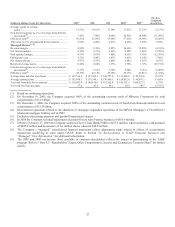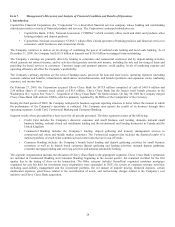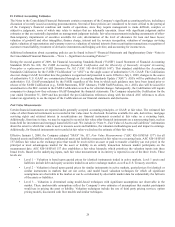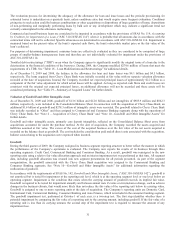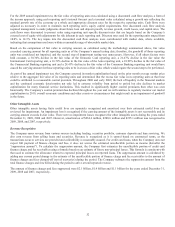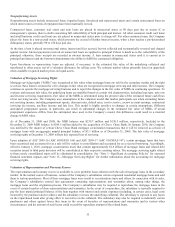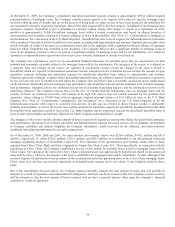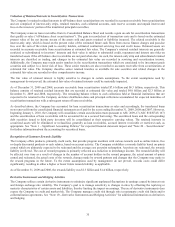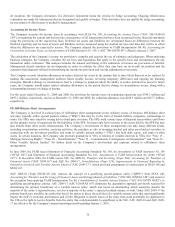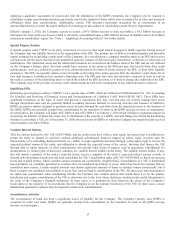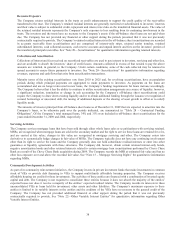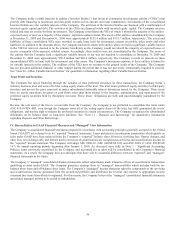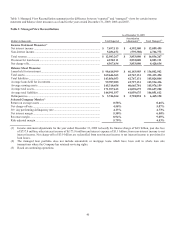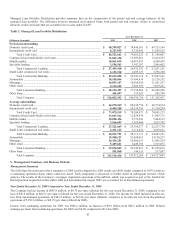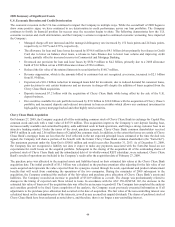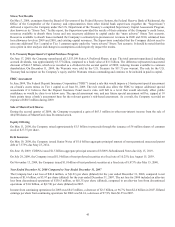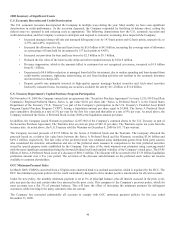Capital One 2009 Annual Report Download - page 50
Download and view the complete annual report
Please find page 50 of the 2009 Capital One annual report below. You can navigate through the pages in the report by either clicking on the pages listed below, or by using the keyword search tool below to find specific information within the annual report. 37
Applying a qualitative assessment of control and with the elimination of the QSPE exemption, the Company will be required to
consolidate certain securitization structures previously used in the transfer of loans which were accounted for as sales and treated as
off-balance sheet loan securitizations. Additionally, certain VIE structures previously accounted for as investments in an
unconsolidated entity or under the equity method of accounting are also subject to consolidation under the new requirements.
Effective January 1, 2010, the Company expects to record a $47.6 billion increase in loan receivables, a $4.3 billion increase in
Allowance for Loan and Lease Losses related to the newly consolidated loans, a $44.9 billion increase in liabilities and a $3.0 billion
reduction in stockholders’ equity. See “Note 1 – Significant Accounting Policies” for further details.
Special Purpose Entities
A special purpose entity (“SPE”) is an entity in the form of a trust or other legal vehicle designed to fulfill a specific limited need of
the Company that was initially involved in the organization of the SPE. The primary use of SPEs is to obtain liquidity and favorable
capital treatment by securitizing certain assets of the Company. In a securitization, a company transfers assets to an SPE and receives
cash proceeds for the assets that have been transferred upon the issuance of debt and equity instruments, certificates or other notes of
indebtedness. The transferred assets and the related debt issuances are recorded on the balance sheet of the SPE and are not reflected
on the Company’s balance sheet. Investors usually have recourse to the assets in the SPE and may also benefit from other credit
enhancements, such as a collateral account or over collateralization in the form of excess assets in the SPE, or from other liquidity
guarantees. The SPE can typically obtain a more favorable credit rating from rating agencies than the transferor could obtain for its
own debt issuances, resulting in less expensive financing costs. The SPE may also enter into derivative contracts in order to convert
the yield or currency of the underlying assets to match the needs of the SPE investors, or to limit or change the credit risk of the SPE.
The Company may be the provider of certain credit enhancements as well as the counterparty to any related derivative contracts.
Qualifying SPEs
Qualifying special purpose entities (“QSPEs”) are a special class of SPEs which are defined in FASB Statement No. 140, Accounting
for Transfers and Servicing of Financial Assets and Extinguishments of Liabilities (“ASC 860-10/SFAS 140”). These SPEs have
significant limitations on the types of assets and derivative instruments they may own and may not actively manage their assets
through discretional sales and are generally limited to making decisions inherent in servicing activities and issuance of liabilities.
QSPEs are passive entities designed to purchase assets and pass through the cash flows from the transferred assets to the investors of
the QSPE. QSPEs are generally exempt from consolidation by the transferor of assets to the QSPE and any investor or counterparty.
As noted above, the Company will adopt ASU 2009-16 and ASU 2009-17 on January 1, 2010 which will have a significant impact on
accounting for transfers of financials assets, due to elimination of the concept of a QSPE, and will change the criteria for determining
whether to consolidate a VIE. As of December 31, 2009, the total assets of QSPEs to which the Company has transferred and received
sales treatment were $46.2 billion.
Variable Interest Entities
VIEs are entities defined in ASC 810-10/FIN 46(R), and are entities that have either a total equity investment that is insufficient to
permit the entity to finance its activities without additional subordinated financial support or whose equity investors lack the
characteristics of a controlling financial interest (i.e., ability to make significant decisions through voting rights, right to receive the
expected residual returns of the entity, and obligation to absorb the expected losses of the entity). Investors that finance the VIE
through debt or equity interests, or other counterparties that provide other forms of support, such as guarantees, subordinated fee
arrangements, or certain types of derivative contracts, are variable interest holders in the entity. The variable interest holder, if any,
that will absorb a majority of the entity’s expected losses, receive a majority of the entity’s expected residual returns, or both, is
deemed to be the primary beneficiary and must consolidate the VIE. Consolidation under ASC 810-10/FIN 46(R) is based on expected
losses and residual returns, which consider various scenarios on a probability weighted basis. Consolidation of a VIE is determined
based primarily on variability generated in scenarios that are considered most likely to occur, rather than based on scenarios that are
considered more remote. Certain variable interests may absorb significant amounts of losses or residual returns contractually, but if
those scenarios are considered very unlikely to occur, they may not lead to consolidation of the VIE. All these facts and circumstances
are taken into consideration when determining whether the Company has variable interest that would deem it to be the primary
beneficiary and require consolidation of the VIE or otherwise rise to the level where disclosure would provide useful information to
the users of the Company’s financial statements. In some cases, it is qualitatively clear based on the extent of the Company’s
involvement or the seniority of its investments that the Company is not the primary beneficiary of the VIE. In other cases, a more
detailed and quantitative analysis may be required to make such a determination.
Securitization Activities
The securitization of loans has been a significant source of liquidity for the Company. The Company typically uses QSPEs to
securitize its credit card loans. QSPEs are generally exempt from consolidation by the transferor of assets to the QSPE and any
investor or counterparty.


